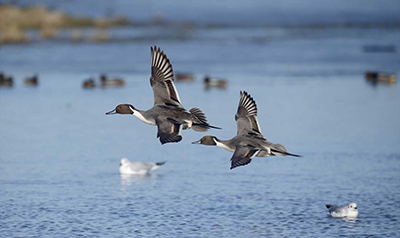Conservation Reserve Program in the 2018 Farm Bill
By: American Farm Bureau
Posted on:02/28/2019Farmers Will Continue to Be Good Stewards of Land and Water
 USDA administers several conservation programs with an emphasis on voluntary land retirement programs, working lands programs and conservation easements. Land retirement programs provide payments to agricultural landowners for temporary changes in land use or management with the goal of conserving soil, water and wildlife resources. Working lands programs allow private land to remain in production, while providing a cost-share and technical assistance to implement various conservation practices and address natural resource concerns specific to the area.
USDA administers several conservation programs with an emphasis on voluntary land retirement programs, working lands programs and conservation easements. Land retirement programs provide payments to agricultural landowners for temporary changes in land use or management with the goal of conserving soil, water and wildlife resources. Working lands programs allow private land to remain in production, while providing a cost-share and technical assistance to implement various conservation practices and address natural resource concerns specific to the area.
While farmers and ranchers are already good stewards of water and land, the 2018 farm bill expands the public-private partnership to increase conservation initiatives with the goal of further improving water quality, wildlife habitats and populations, as well as protecting other natural resources. Today’s article reviews the major changes to the Conservation Reserve Program. A future article will review the changes made to the Environmental Quality Incentives Program and the Conservation Stewardship Program.
Conservation Reserve Program
CRP is the largest federally administered private-land retirement program, with annual outlays approaching $2 billion per fiscal year and an average payment of $77 per acre. CRP enrollment is capped each year, and under the 2014 farm bill, enrollment was limited to no more than 24 million acres during fiscal years 2017 and 2018.
For fiscal year 2017, the latest data available, Farm Service Agency data revealed 23.4 million acres were enrolled in CRP. Enrollment was the highest in Texas, at 2.9 million acres, followed by Kansas, at 2.1 million acres. The top five states in terms of CRP enrollment were Texas, Kansas, Iowa, Colorado and North Dakota. Combined, these states have more than 10 million CRP acres and represent approximately 43 percent of all CRP ground.
CRP provides financial compensation to landowners who voluntarily remove highly erodible and environmentally sensitive lands from agricultural production and install resource-conserving practices or preserve wildlife habitat. For example, the U.S. Fish and Wildlife Service estimated that since 1992 the Conservation Reserve Program has contributed to a net increase of approximately 2 million additional ducks per year.

Changes Made in the 2018 Farm Bill
The 2018 farm bill makes several modifications to the CRP program. First, the acreage cap under CRP is expanded to 27 million acres by 2023. However, acreage enrollment will be based upon historical state enrollment rates, and then 1 million to 2 million acres of CRP land must be dedicated grasslands that have a positive impact on water quality such as grass waterways, wetlands or wetland buffers. Figure 4 identifies historical and congressionally capped CRP acreage.
CRP was also modified to help farmers and ranchers during times of drought, flooding or wildfires by allowing emergency haying and grazing, as well as other forage uses, on CRP grounds--without a reduction in rental rates. This flexibility is greatly needed given recent droughts and natural disasters impacting agriculture.
While there were several other improvements to CRP, including additional support for beginning farmers and veterans, one of the more significant modifications was a reduction in CRP rental rates. The 2018 farm bill reduces CRP rental rates to no more than 85 percent of the county rental rate for CRP general sign-up and no more than 90 percent of the county rental rate for CRP continuous sign-up. This is designed to better align CRP rental rates with market-based rates and should improve the availability of farmland for farmers and ranchers.
Summary
CRP is a land retirement program that provides payments to agricultural landowners for temporary changes in land use or management with the goal of conserving soil, water and wildlife resources. Currently, fewer than 24 million acres are enrolled in CRP.
The 2018 farm bill modifies CRP to improve resource and wildlife conservation practices by expanding the acreage cap to as many as 27 million acres by 2023. However, the bill also makes improvements in other areas of the program such as market-based rental rates and emergency haying and grazing during natural disasters.
Combined, changes made in the CRP program will ensure that farmers and ranchers continue to be good stewards of wildlife habitats, land and water.
 Sign In
Sign In
 Sign In
Sign In
